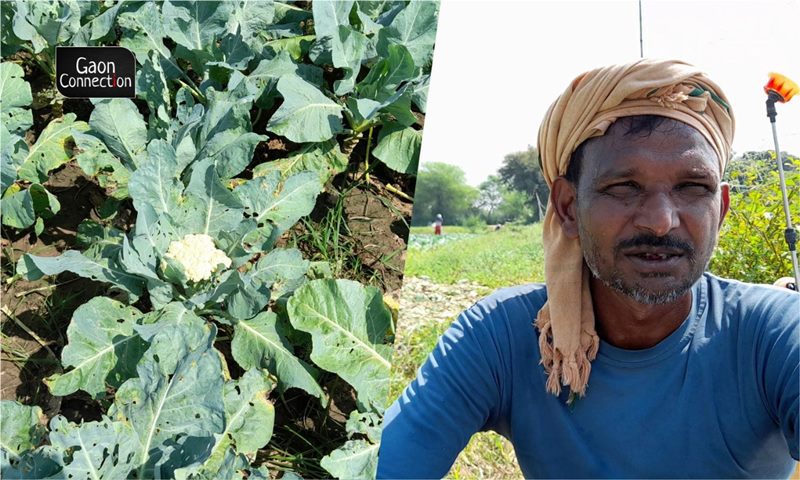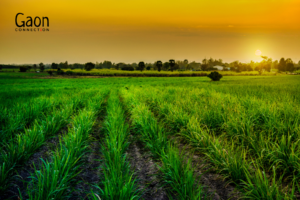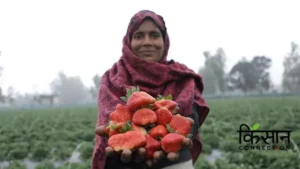Satna, Madhya Pradesh
Cauliflowers in Satna, Madhya Pradesh have always been the farmers’ friend. Along with other kharif crops of urad dal, moong dal, til (sesame) and paddy, the cauliflower has earned its cultivators considerable profit. However, it has not been so this year and the farmers are mystified.
The leaves of the vegetables are green, healthy looking and in proliferation, but there are hardly any cauliflowers growing.
“This is the first time in fifteen years that there is barely any yield of cauliflowers in my field,” Ram Siya Kushwaha, a cauliflower farmer, told Gaon Connection.
Ram Siya is a 46-year-old sharecropper farmer from Bharri village in Satna where many farmers grow cauliflower. He had cultivated cauliflowers on three acres of land. Like him several other farmers in the district had grown cauliflower but there is no crop.
“I had spent eight thousand rupees on buying the seeds for the crop this year. But all of it was for nothing because I got no produce at all,” he lamented.
Also Read: Using indigenous seeds to sustain livelihoods, fight climate change and pay off loans
Somewhat similar is the plight of Vineet Kushwaha from Bharri village. “I ploughed my land clean of the cauliflower I had planted there as there was no yield at all,” the 32-year-old farmer told Gaon Connection. He had spent Rs 6,000 on seeds alone and sowed them in July, but there was nothing to show for it.
The ‘cauliflower villages’ of Satna
Approximately, 29.34 million hectares of land are under cauliflower cultivation in Madhya Pradesh. Of that, Satna district grows cauliflower in 1,812 hectares.
Gourhati, along with villages such as Bharri, Turri, Atra, and Dadhiya in Keochehra block in Satna district are full of cauliflower fields. In fact these villages are referred to as the ‘cauliflower villages’.
“Nearly 75 per cent of the farmers from these five villages grow cauliflower in about five hundred acres of land,” Ramsiya, who has been growing cauliflower for nearly 15 years, told Gaon Connection.
Also Read: Green chilli farmers in the red
Quoting the third production estimate for the year 2021, Narayan Singh Kushwaha, deputy director, horticulture department, Satna, told Gaon Connection that the acreage of cauliflower was actually growing with the annual production at more than 50,000 metric tonnes.
The total acreage under cauliflower cultivation in Satna district is 1,812 hectare of which 579 hectares are of the kharif season (monsoon) and 1,233 hectares are of the rabi season (winter). Annually, 51,833 metric tonnes of cauliflowers are grown in the district of which 4,905 metric tonnes are from the kharif season and 43,632 metric tonnes are from rabi.
Not so safe safety net
Cauliflower is usually sowed between the months of September and October. This year, the farmers sowed it earlier, in July-August.
Very often, the farmers grow cauliflower as a safety net, in the event of their other crops failing them. Increasingly, farmers are turning to vegetables as an assured source of income in case their kharif crops of paddy, til, urad and moong don’t do well.
“We grow cauliflower to tide over losses from our other crops. But this year there has been no cauliflower yield at all. Now, even the leaves are infected and I had to spend more money on pesticides,” Raj Bahadur Kushwaha, a 26-year-old farmer from Gourahti village, Satna, told Gaon Connection.
Some farmers are still hoping for a miracle. “Everything was going fine. I have been cultivating cauliflowers for eight years now. Even this time the plants look healthy enough but there is no cauliflower growing at all,” Munna Varma, from Dadhiya village, told Gaon Connection. The 38-year-old farmer hoped that the urea he had just put would help the vegetables show up.
Also Read: Fertilisers ‘shortage’, exhausting queues throw farmers in turmoil
The reason for the non appearance of the cauliflowers could be because they were sowed early, said Rajesh Singh, horticultural scientist from Rewa district. “The cauliflower is a 60-day crop and should have been ready to harvest by now, but that has not happened,” Rajesh Singh said.
The horticulture scientist also strongly advised farmers against putting more urea in their fields. “It might make the plant grow better but will have no effect on the flower,” he said.
Read the story in Hindi



















